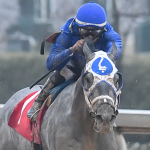
Preakness Quick Sheet: Get to Know the 2021 Preakness Horses

I was working in my office one day with my television tuned on horse racing, as usual. Woodbine Harness was among the last racing signals for the evening. I looked up and saw in the upcoming race 2 that the #5 horse, Montana Ben, had a morning line odds of 3-1, yet was 17-1 in the actual betting.
Now in all candor, I don’t bet a lot of harness races. I didn’t even have a Woodbine Harness program or past performances in front of me. But I do have a cell phone, a horse racing phone account and a system which Montana Ben fell into.
I bet $2 to win on #5 Montana Ben. In using my system, I figure that if the morning line maker at Woodbine was sharp, I was getting a huge overlay in the win price. I have a horse at 17-1 odds that should be closer to 3-1.
Montana Ben sat mid-pack while a 2-5 favorite motored on the lead. My horse moved up with cover on the outside of horses and then took over the lead turning for home. The driver on the favorite didn’t seem to mind. He conceded the lead and sat second into the stretch.
As expected, the driver tipped the favorite out with full confidence he would pass Montana Ben in the final 150 yards. However, Montana Ben dug in and held on to win by a head.
Montana Ben paid $36.70. Most of you would call it dumb luck. But it’s not. In my newcomers book Betting on Horse Racing for Dummies, I explain this system on page 161.
We all know novices who go to the racetrack for the first time and bet on a whim. It may be on the color of a horse. On a cute name. Or on a favorite number. The list is endless.
I can understand why. Since most do not yet know how to handicap, they still want to have some action.
Well, the example I gave from the Woodbine race is something I do suggest to newcomers that I meet. It is so simple and takes so little time. Plus it can make a day profitable with just one winning horse.
The thing is, professional horseplayers either make their own morning line or have a good idea what the real odds of a horse are in a race. Newcomers cannot be expected to have that kind of knowledge.
So, I start with the premise that the morning line maker at the track is competent if not very good at his or her craft. What a good morning line represents is a reflection of how the public is going to bet the race. But it does not indicate which horse the line maker likes to actually win the race.
In essence, you are letting the line maker handicap the race for you. Now, where my angle for a newcomer comes into play is to look for potential overlay horses. An overlay is a horse that goes off at win odds that are much higher than it deserves to have.
In the case of Montana Ben, the line maker predicted the betting public would wager enough money to give the horse 3-1 odds as the race went off. Well, for whatever reasons, the public didn’t like the horse and he went off at 17-1 odds. I bet $2 with the belief the morning line maker was right and the public was wrong. This was a quintessential overlay.
When you bet horses at overlaid odds, you don’t have to be right as often as when you bet favorites to win. You are getting great value on a horse the morning line maker believes is live.
Just put this concept in the back of your mind. The next time you’re with a novice at the racetrack, suggest this as an easy, fun way to bet with a little logic in your favor.
Richard Eng is the author of “Betting on Horse Racing for Dummies”, an introductory book for newcomers to the sport of horse racing. For two decades, he was the turf editor and handicapper for the Las Vegas Review-Journal. He still handicaps the Southern California tracks and his picks are for sale at www.racedaylasvegas.com. You can email him at rich_eng@hotmail.com and follow him on Twitter at @richeng4propick and on Facebook.com.